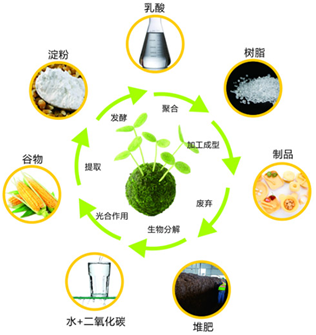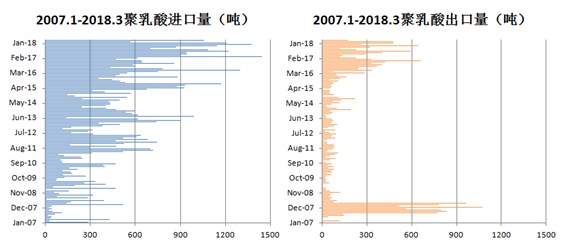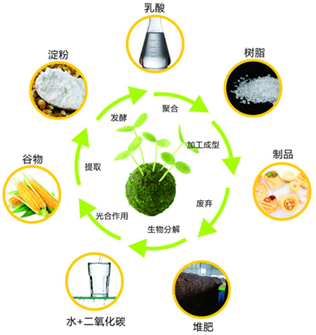传统高分子材料给人们带来无数便利的同时,也给环境带来了诸多负担,“白色污染”正在成为一个日趋严重的问题。在此背景下,聚乳酸(PLA)作为近年来产业化发展最快的生物降解材料,可以在一定条件下实现快速的降解,得到了越来越多的关注。2019年,全球及中国聚乳酸项目建设火热,规划产能已达百万吨,且聚乳酸应用广泛,可用于注塑、薄膜、片材和纤维等,未来具备逐步取代传统塑料的潜力。
“中国制造2025”将聚乳酸等生物降解材料列入高分子材料重点发展对象,科技部《“十三五”材料领域创新专项规划》明确提出耐高温聚乳酸等新型生物基材料的技术提升与产业升级是发展重点之一。
聚乳酸(PLA),又称为聚丙交酯,以乳酸为单体,脱水聚合而成。其以玉米、木薯、秸秆等可再生生物质为原料,来源广泛且可再生。聚乳酸制品使用后可以堆肥降解成CO2和水,实现在自然界中的循环。

聚乳酸生态循环示意图
聚乳酸合成
聚乳酸合成主要有2种方法。
Ø 一步法:乳酸直接脱水缩聚。

直接缩聚法
该法优点在于单体转化率较高,工艺简单,不需要经过中间体的纯化,因而成本较低,主要问题是产物的分子量及其分布难以控制,不易得到高分子量的聚合物。目前国内仅使用同济大学技术的同杰良公司采用一步法制聚乳酸。
Ø 二步法:乳酸先脱水生成低聚物,然后解聚生成丙交酯,再开环聚合制得聚乳酸。

开环聚合法
用该方法可以得到分子量和微观结构均可调的聚乳酸,但丙交酯开环聚合法要经过丙交酯纯化的步骤,生产流程长,成本较高。目前聚乳酸的生产主要采用丙交酯开环聚合工艺。
PLA本身属脂肪族聚酯,具有通用高分子材料的基本特性,有着良好的机械加工性能,能够胜任大多数合成塑料的用途,目前主要用于制作包装材料、一次性餐具、纤维、3D打印耗材等。
全球聚乳酸主要生产企业
企业 | 项目地点 | 产能(kt/a) | 主要应用 |
NatureWorks | 美国 | 150 | 挤出和热成型、注塑、吹塑、发泡、薄膜、片材、纤维、3D打印等 |
Total Corbion | 泰国 | 75 | 注塑、薄膜、片材、纤维、热成型等 |
Teijin | 日本 | 1 | 纤维 |
Synbra | 荷兰 | 5 | 发泡 |
海正生物 | 浙江 | 15 | 注塑、薄膜等 |
同杰良 | 上海+安徽 | 11 | 注塑、薄膜、片材、纤维等 |
吉林中粮 | 吉林 | 10 | 注塑、片材、纤维等 |
允友成 | 江苏 | 10 | 注塑等 |
恒天长江 | 江苏 | 10 | 纤维 |
光华伟业 | 湖北 | 10 | 3D打印等 |
河南龙都天仁 | 河南 | 6 | 薄膜、片材等 |
江苏九鼎 | 江苏 | 5 | 薄膜、纤维等 |
九江科院生物 | 江西 | 1 | 纤维、3D打印等 |
NatureWorks长期占据聚乳酸行业半数以上市场;道达尔和科碧恩成立合资公司Total Corbion,于2017年在泰国投建万吨级聚乳酸工厂,2018年12月正式投产;浙江海正于2015年扩建1万吨聚乳酸,在当时产能位列全球第二。随着聚乳酸合成技术打破国外垄断并日趋成熟,中国聚乳酸产业已经进入发展的快车道,企业开始以万吨级甚至十万、百万吨级规模规划和建设聚乳酸项目。
于2015年立项启动的浙江海正5万吨聚乳酸项目预计将在2019年四季度释放产能,届时海正将形成聚乳酸产能6.5万吨/年;九江科院生物化工有限公司2017 年中首期千吨级工程建成投产,二期万吨级高性能聚乳酸及改性生物降解材料生产线在建设中;2018年8月,吉林中粮生物万吨级聚乳酸装置试车成功,已开始筹划建设年产10万吨聚乳酸项目。
2018年,金丹生物新材料采用南京大学首创的有机胍催化定向聚合生产丙交酯和聚乳酸的工艺技术,已于河南建成“1万吨/年L-丙交酯联产1000吨/年聚L-乳酸”连续化生产装置,预计2020 年扩建规模至10-15万吨。
无锡南大绿色环境友好材料技术研究院有限公司采用南京大学“生物质有机胍催化法全绿色工艺合成聚乳酸”原创技术正在建设“5000 吨/年聚L-乳酸”连续化生产装置,计划实现稳定生产后立即开展10万吨/年聚L-乳酸连续化生产装置的设计与建设。
2018年上半年,恒天长江建成国际上第一条万吨聚乳酸连续聚合熔融直纺纤维及制品生产线。采用自主研发的“聚乳酸熔体直纺”技术,不经切片,能耗成本降低30%,整体可节省2100元/吨。
2018年6月,丰原集团年产10万吨聚乳酸项目于安徽固镇县奠基,目前固镇丰原生物产业基地玉米--乳酸--丙交酯--聚乳酸的全产业链加工线正在建设中。2019年3月,通辽经济技术开发区与丰原集团签约“百万吨级生物新材料聚乳酸”项目,该项目总投资120亿元,计划分三期建设,一期项目投资50亿元,年产30万吨聚乳酸,计划2019年开工建设,2021年建成投产。
进出口数据

亚化咨询整理了2007年1月至2018年3月初级形状的聚乳酸海关进出口数据,2007年至2008年初期,中国聚乳酸主要用于出口,国内需求小;2008-2015年期间出口量较为稳定,国内需求稳步增长,推动进口量不断增长;2015-2018年期间,中国新建/扩建聚乳酸项目相继释放产能,且产品质量受国际市场认可度越来越高,出口量明显上升;2017年来聚乳酸进口量的明显增加,显示出中国聚乳酸市场增长开始提速。
中国聚乳酸的市场正在保持稳步增长,且有加速增长的趋势,而聚乳酸出口退税率在2018年内两度上调,从5%提高至10%,一定程度上给企业让利,有利于聚乳酸企业开拓国际市场。
降解塑料的前景毋庸置疑,但目前国家对其的政策多集中在技术研究层面,亚化咨询认为,在国家对降解塑料市场有明确的激励机制之前,对于中国聚乳酸行业,应不断降低生产成本,提高产品竞争力;加强产业链上下游合作,原材料制造商应密切关注下游制品需求,不断改进材料性能,以市场为导向,扩大聚乳酸应用。
2019可降解塑料技术与市场论坛将于4月24-25日在云南昆明召开。会议将探讨可降解塑料政策发展趋势与市场机遇,八大可降解塑料—聚乳酸(PLA)、淀粉类(PSM)、聚酯类(PBS/PBAT/PBSA)、聚羟基脂肪酸酯(PHA)、聚己内酯(PCL)、聚乙醇酸(PGA)、CO2共聚物和聚乙烯醇(PVA)—生产技术与成本降低展望,可降解塑料原料多元化与下游应用领域的拓展,可降解塑料完全生物降解条件与机理研究等。
Polylactic acid capacity will enter the million-ton scale in few years, will it replace traditional plastics?
l Degradable Plastic Technology and Market Forum 2019 will be held on April 24-25 in Kunming, Yunan, China
l Key technologies for polylactic acid synthesis will be an important topic of the forum
l This forum will also discuss high value innovative application of PLA materials
Traditional polymer materials bring countless conveniences to people, and they also bring a lot of burden to the environment. "White pollution" is becoming an increasingly serious problem. Under this background, polylactic acid (PLA), as the fastest biodegradable material in industrialization in recent years, can achieve rapid degradation under certain conditions, and has received more and more attention. In 2019, the global and Chinese PLA projects were booming, with a planned production capacity of over one million tons. PLA is widely used in injection molding, film, sheet and fiber, and has the potential to gradually replace traditional plastics in the future.
"Made in China 2025" listed PLA and other biodegradable materials as the key development targets of polymer materials; the Ministry of Science and Technology's "13th Five-Year Plan for Innovation in the Field of Materials" clearly states that technological improvement and industrial upgrading of new bio-based materials such as high-temperature resistant polylactic acid are one of the development priorities.
Polylactic acid (PLA), also known as polylactide, is formed by dehydration polymerization using lactic acid as a monomer. It uses renewable biomass such as corn, cassava and straw as raw materials, and its raw materials are widely available and renewable. PLA products can be decomposed into CO2 and water after composting to achieve circulation in nature.

Schematic diagram of PLA ecological cycle
Synthesis of PLA
There are two main methods for synthesizing PLA.
Ø One-step method: Direct synthesis of PLA by dehydration polycondensation of lactic acid

The method has the advantages of high monomer conversion rate, simple process, no purification by intermediates, and low cost, and the main problem is that the molecular weight and distribution of the product are difficult to control, and it is difficult to obtain a high molecular weight polymer. At present, Tongjieliang Company, which only uses the technology of Tongji University, adopts one-step method to prepare PLA.
Two-step method: The lactic acid is dehydrated to form an oligomer, and then depolymerized to form lactide, which is then subjected to ring-opening polymerization to obtain PLA.

Polylactic acid with adjustable molecular weight and microstructure can be obtained by this method, but the lactide ring-opening polymerization method is subjected to the step of purifying lactide, and the production process is long and the cost is high. At present, the production of PLA mainly adopts two-step method.
PLA itself is an aliphatic polyester, which has the basic characteristics of general-purpose polymer materials, has good mechanical processing properties, and is suitable for most synthetic plastic applications. Currently, it is mainly used for packaging materials, disposable tableware, fiber, 3D printing consumables, etc.
The world's major producers of PLA
Company | Location | Capacity (kt/a) |
NatureWorks | USA | 150 |
Total Corbion | Thailand | 75 |
Teijin | Japan | 1 |
Synbra | Netherlands | 5 |
HISUN | Zhejiang, China | 15 |
Tongjieliang | Anhui+Shanghai, China | 11 |
Jilin COFCO | Jilin, China | 10 |
SUPLA | Jiangsu, China | 10 |
CHTC ECOSPIRE | Jiangsu, China | 10 |
eSUN | Hubei, China | 10 |
Longdu Torise | Henan, China | 6 |
Jiuding | Jiangsu, China | 5 |
Jiangxi Keyuan Bio-Material | Jiangxi, China | 1 |
NatureWorks has long occupied more than half of the market in the PLA industry; Total and Corbion have established a joint venture company, Total Corbion, to build 10,000-ton class PLA plant in Thailand in 2017, and officially put into operation in December 2018; HISUN expanded 10,000 tons of PLA in 2015, which ranked second in the world at that time. As PLA synthesis technology breaks foreign monopoly, China's PLA industry has entered the fast lane of development, and enterprises have begun to plan and build PLA projects on a scale of 10,000 tons or even 100,000 tons.
HISUN 50,000 tons PLA project initiated in 2015 is expected to release capacity in the fourth quarter of 2019, when HISUN will form a PLA production capacity of 65,000 tons/year; Jiangxi Keyuan Bio-Material completed the first phase of the 1,000-ton project in 2017, and the second phase 10,000-ton high-performance PLA and modified biodegradable material production line is under construction; In August 2018, the Jilin COFCO 10,000tons PLA Plant was successfully commissioned, plans to build a PLA project with an annual output of 100,000 tons.
In 2018, Jindan Bio-New Materials used the process technology of organic guanidine catalyzed directional polymerization to produce lactide and polylactic acid, which was initiated by Nanjing University. It has built a “10,000 tons/year L-lactide co-production of 1,000 tons/year PLA in Henan. The poly L-lactic acid continuous production plant is expected to expand to 10,000-150,000 tons in 2020.
Wuxi Nanda Green Environmentally Friendly Materials Technology Research Institute Co., Ltd. is using the original technology of “Bio-organic guanidine catalysis method for the synthesis of polylactic acid”. The “5000 ton/year poly L-lactic acid” continuous production device is being built, and the plan is, after the stable production, the design and construction of a 100,000-ton/year poly L-lactic acid continuous production plant will be carried out Immediately.
In the first half of 2018, CHTC ECOSPIRE built the international first production line of 10,000 tons of polylactic acid continuous polymerization and melting direct spinning fiber and products. Adopting the self-developed “polylactic acid melt direct spinning” technology, the energy cost can be reduced by 30%, and the overall saving can be 2100 yuan/ton.
In June 2018, BBCA Group's annual production of 100,000 tons of polylactic acid project was laid in Guzhen County, Anhui Province. At present, the whole industry chain processing line of corn-lactic acid-lactide-polylactic acid in Guzhen BBCA Bio-industry Base under construction. In March 2019, Tongliao Economic and Technological Development Zone signed a project of “Million-ton-class bio-new material polylactic acid” with BBCA Group. The total investment of the project is 12 billion yuan. It is planned to be constructed in three phases. The first phase of the project will invest 5 billion yuan, with an annual output of 300,000 tons of polylactic acid, it is planned to start construction in 2019 and be completed and put into operation in 2021.
Import and export

ASIACHEM compiled the import and export data of polylactic acid in the primary shape from January 2007 to March 2018. From 2007 to early 2008, China's polylactic acid was mainly used for export, and domestic demand was small. Export volume during 2008-2015 is relatively stable, domestic demand is growing steadily, makes imports are growing. During the period of 2015-2018, China's new/expanded polylactic acid projects have successively released production capacity, and the quality of products has been recognized by the international market, and the export volume has increased significantly.
The market for polylactic acid in China is growing steadily and has a tendency to accelerate growth. The export tax rebate rate for polylactic acid has been raised twice in 2018, from 5% to 10%, to a certain extent, allow enterprises to retain more profits, which is beneficial to polylactic acid enterprises to open up the international market.
The prospect of degradable plastics is unquestionable, but the current state policy on them is mostly concentrated on the technical research level. ASIACHEM believes that before the country has a clear incentive mechanism for the degradable plastics market, the Chinese polylactic acid industry should continuously reduce production costs and improve product competitiveness; strengthen upstream and downstream cooperation in the industrial chain, raw material manufacturers should pay close attention to the demand for downstream products, continuous improvement of material properties, market-oriented, expanding polylactic acid applications.
Degradable Plastic Technology and Market Forum 2019 will be held on April 24-25 in Kunming, Yunan, China. The upcoming conference will discuss degradable plastics policy development trends and market opportunities, production technology and cost reduction of eight major degradable plastics - PLA, PSM, Dibasic acid glycol copolyester (PBS/PBSA/PBAT), PHA, PCL, PGA, PVA and CO2 copolymers, diversification of degradable plastic raw materials and expansion of downstream applications, development and application of seawater degradable materials, etc.